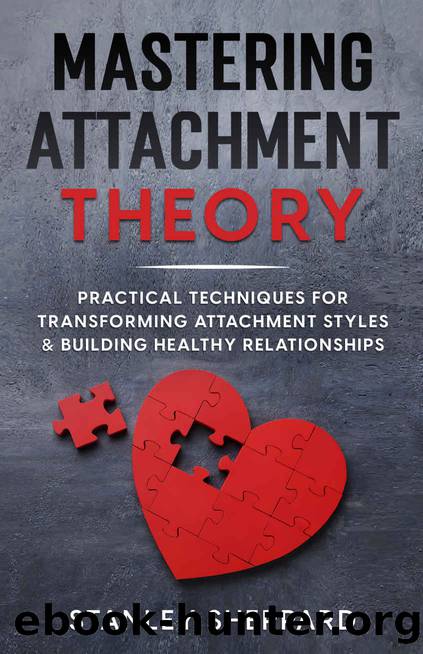Mastering Attachment Theory: Practical Techniques for Transforming Attachment Styles & Building Healthy Relationships (Mental Health Book 4) by Stanley Sheppard

Author:Stanley Sheppard [Sheppard, Stanley]
Language: eng
Format: azw3
Published: 2023-07-29T00:00:00+00:00
Key Takeaways:
1. Developing authentic connections requires navigating societal expectations and overcoming barriers to authenticity.
2. Social expectations and masks can hinder our ability to express our true selves and form genuine connections.
3. Understanding attachment styles can shed light on our tendency to conform and the fear of rejection that may accompany it.
4. Active listening is a crucial skill in building authentic connections, involving being fully present, showing empathy, and validating others' experiences.
5. Vulnerability plays a transformative role in relationships, deepening connections and fostering trust.
6. Gradually sharing personal experiences and emotions can create a supportive environment for reciprocating vulnerability.
7. Building authentic connections takes time, trust, and a commitment to creating a safe space for open communication.
Now that we've explored developing authentic connections and overcoming barriers to authenticity, it's time to take action and apply this knowledge in your own life. The following action steps will guide you toward fostering genuine and meaningful connections with others.
1. Reflect on your attachment style: Take a moment to reflect on it and how it influences your behaviors and interactions in relationships. Understanding your attachment patterns will help you consciously navigate them and adjust as needed.
2. Reflect on your attachment style: Take a moment to reflect on it and how it influences your behaviors and interactions in relationships. Understanding your attachment patterns will help you consciously navigate them and adjust as needed.
3. Practice active listening: Make a conscious effort to engage in active listening during your conversations. Be fully present, show empathy, and validate the experiences of others. Incorporate active listening techniques such as reflecting, summarizing, and asking open-ended questions to deepen your understanding of others' perspectives.
4. Embrace vulnerability: Gradually open up and share aspects of your true self with others. Start by sharing less intimate experiences and emotions, and gradually work towards sharing more profound vulnerabilities. Remember to respect your boundaries and comfort levels while creating a supportive environment that encourages reciprocating vulnerability.
5. Cultivate a supportive network: Surround yourself with individuals who value authenticity and create a safe space for genuine connections. Seek out relationships where vulnerability is met with empathy and understanding. Nurture these connections by reciprocating vulnerability and actively listening to others.
In the next chapter, we will dive into the fascinating world of mindfulness and somatic practices and explore how they can enhance our ability to form authentic connections. Discover the power of being fully present at the moment, tuning into your body's wisdom, and cultivating deeper awareness in your interactions. Join us as we explore practical exercises and techniques that integrate mindfulness and somatic practices into your journey of developing authentic connections.
Download
This site does not store any files on its server. We only index and link to content provided by other sites. Please contact the content providers to delete copyright contents if any and email us, we'll remove relevant links or contents immediately.
The Power of Now: A Guide to Spiritual Enlightenment by Eckhart Tolle(4763)
The Miracle Morning by Hal Elrod(3918)
Rising Strong by Brene Brown(3786)
Being Aware of Being Aware by Rupert Spira(2710)
The Secrets to Charisma and Personal Magnetism: Learn a hidden energy tradition to become magnetically attractive and vitally alive by Martins Bruno(2406)
The Lost Art of Good Conversation by Sakyong Mipham(2128)
The Gifts of Imperfection by Brene Brown(2120)
The Songlines by Bruce Chatwin(2114)
A New Earth: Awakening to Your Life's Purpose by Eckhart Tolle(1978)
The Power Of Now by Eckhart Tolle(1862)
All Things New by John Eldredge(1784)
The Untethered Soul: The Journey Beyond Yourself by Singer Michael A(1730)
The Nature of Consciousness by Rupert Spira(1692)
The Empath's Survival Guide by Judith Orloff(1666)
Thoughts Without A Thinker: Psychotherapy from a Buddhist Perspective by Epstein Mark(1594)
Practicing the Power of Now by Tolle Eckhart(1556)
The Seat of the Soul by Gary Zukav(1552)
Be Feel Think Do by Anne Berube(1538)
The Yoga of Jesus: Understanding the Hidden Teachings of the Gospels by Paramahansa Yogananda(1532)
